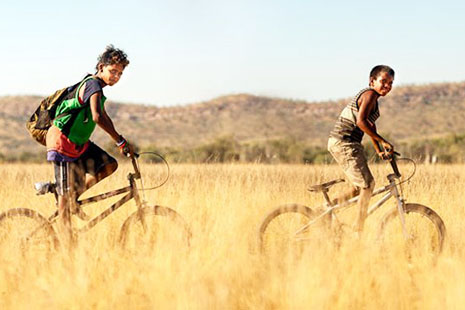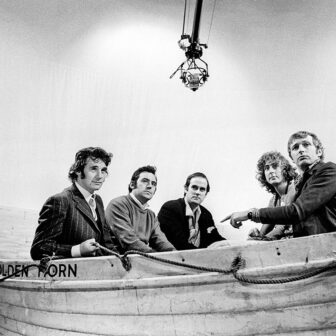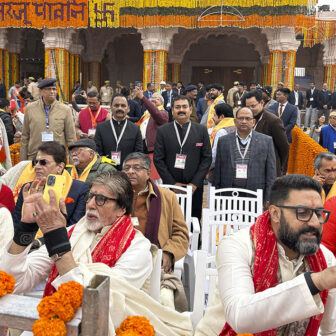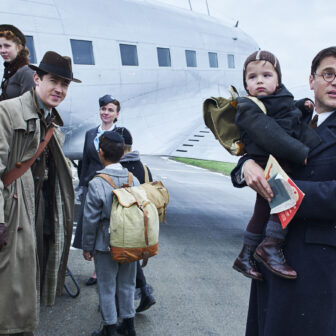THE small cinema is packed for Satellite Boy, and that in itself is of interest; these days the urban middle-class audience takes it for granted that its movie-going will include works centred on Aboriginality and remote Australia. In a few years, the screen has widened further. The impact of Samson and Delilah, with its vivid energy, was decisive; and if The Tracker, Ten Canoes, Beck Cole’s Here I Am, and Ivan Sen’s Beneath Clouds and Toomelah were all smaller successes, they also extended viewing imaginations, the sense of which country we’re in.
Satellite Boy was written and directed by Catriona McKenzie, who shares its authorship with Geoffrey Simpson. Simpson’s cinematography brilliantly delivers the grandeurs of the Kimberley; in its forest the film begins and ends. As the seats empty, fragmentary discussions break out immediately – the plot was a bit thin, the land outside Wyndham isn’t like that, surely those caves are hundreds of miles from where the kids were supposed to be, wasn’t it a bit disconnected, that satellite dish came from nowhere. Other voices come in, saying But – and those voices struggle: in immediate responses it’s hard to find words for the merits of a film like this, very simple on its surface – easily saleable, in fact, as a kids’ film – while towing too much history in its depths. A boy and his grandfather emerge in the landscape; they’ve been hunting, and the old man Jagamarra (David Gulpilil) is shouldering a large goanna. The boy, Pete (Cameron Wallaby), is taking in lessons about his connection to country, a connection which is under threat. There’s a mining company around, threatening to evict the small family from its living place, a stretch of land around a disused drive-in cinema. Its skeleton stands there, bizarre and useless, a sign of abandoned modern enterprise. Pete, aged around ten, will go off with his mate Kalmain (Joseph Pedley), find the mining company manager and tell him they’re not going to go. Kalmain is fleeing the prospect of detention in a boys’ home; they spar when he taunts Pete about his absent mother – she doesn’t want him, she’s never coming back. Pete insists that she is, and that they’re going to open a restaurant.
The substance of the film is their trek: as they travel, there are no realistic links between one geography and another. Drying mud flats; grasslands; open bush; a great gorge; a tract of parched desert, with an abandoned satellite dish – like the drive-in screen, a fragment of failed modernity. There’s the long road, where the boys lose their bikes and their shoes. There’s the running river – but Pete can’t swim; here, for once, it’s Kalmain who has the skill they need; there’s the giant earthmoving machinery and the hills of red dust, there’s the ancient artwork on the rocks. There’s the town, where Pete does find the errant mother, Lynelle (Rohanna Angus), who is not after all doing hospitality training; she thinks it would be nice to take Pete off to a suburban house in Perth. She buys him a white shirt; with that object, the symbolism resounds too heavily when he leaves her (“You have your dream, I have mine”) and, in a violent gesture, throws the shirt away. His dream has changed; the restaurant ambition dissolves; “country” requires something else. The authorities catch up with the rebel Kalmain, and they’ll take him away, but the boys swear that they’re “friends forever.”
A kids’ film? Yes, but also one for grown-ups; one caught in an expanding network of stories in which easy resolutions are refused. McKenzie’s narrative strategies are modernist, working in concentrated segments. Some knowledge is presupposed; the film banks on an audience that knows some history, and has grown respect for profound cultural difference. This Indigenous director has worked in television, with episodes of Redfern Now and The Circuit among her many credits; the shift to cinema is a move away from structured, realistic drama. There are distant echoes of Walkabout, filmed when David Gulpilil, brilliantly performing at its centre, was sixteen (even then, there were people chattering that he had to be one of the best actors on the planet); echoes too of the end of Luhrmann’s Australia, where he was the venerable authority figure King George, to whom the child returns at the end; and here his character is given a name echoing that of the mythic Kimberley warrior, Jandamarra. Pete, painted with white clay in the course of initiation, dances with his own.
This is not a fairytale; the child won’t defeat the mining company, and there are no sentimentalities here about young Aborigines taking the best from both worlds. It’s rather a fable; Gulpilil’s complex presence, and the images of the sky full of stars, signal that from the beginning. David Bridie’s music bridges the narrative gaps, tracing Pete’s wandering orbit; doing superbly what film music exists for, with light counterpoint following the trek, the score intensifying – human voices mingling and echoing with instruments – when the story darkens. It’s not the first time that Bridie’s music has served a story of marginalised people; it is of great importance, for example, in Charlie Hill-Smith’s Strange Birds in Paradise, one of very few documentary treatments of the West Papuan struggle (and one worth ferreting out). Now, in the knowledge that Satellite Boy was a long time in development, I still seek from Catriona McKenzie and her co-professionals a different but related story: one in which there’s a girl, along with a mother or grandmother, at the centre of the ethical quest.
ALEX GIBNEY’s We Steal Secrets: The Story of WikiLeaks is a seductively ingenious documentary, its tale of subversive revelations on post-2001 warfare rendered in a fast-moving, brilliantly edited compilation of graphics, archival film, news footage, text on screen and interview. We are entertained, but should not accept this account as an adequate history. To the crazy-brave WikiLeaks project, we owe that essential video fragment tagged “Collateral Murder,” showing the needless deaths of Reuters journalists Saeed Chmagh and Namird Noor-Eldeen in New Baghdad, and recording the horrifically matter-of-fact dialogue from the hovering Apache. The worldwide dissemination of those sounds and images discredited, forever, the mythology of the “free world” against the Middle Eastern rest. It also showed that with a degree of motivated cunning, our penetrable information systems are not titanic monsters; they can be made to serve the world as instruments. For that we are in permanent debt to the rebel hackers, Julian Assange and his initial cohort. The punitive authorities – Swedish, British, American – may finally entrap Assange. However narcissistic and vain he may now be, one hopes not; but even if they do, a whole flock of genies are out of their bottles, and transparency must now be demanded of governments as once, pre-WikiLeaks, it was not.
Gibney’s film does well to open to wider knowledge the dilemmas of the brave, gifted and pitiable Bradley Manning; but in its nastiness about Assange, it loses the main plot. Gibney couldn’t resist the individual drama. The young man’s evident vanity and paranoia, and his sexual adventures, are of absolutely no importance in comparison to the main issue of access to knowledge about what governments and national military forces are getting up to, and what they’re doing to populations in the process. The United States still operates malign fantasies about the usefulness to national security (whatever they think that is) of lethal operations with drones in situations where the question of who’s getting killed is left horribly unclear; the only point is to go on killing. That, so far as we can tell, is where we are now. WikiLeaks has broken up, but electronic detective work by its inheritors (OpenLeaks, Anonymous?) can be of great value in pushing the world a few centimetres forward.
SOME weeks ago I promised discussion of Baz Luhrmann’s The Great Gatsby, which – after saturation promotion and ubiquitous exposure, with all sorts of tie-ins and spinoffs, and Leonardo DiCaprio’s intense gaze demanding your attention at every bus stop – has now retreated to the corners of the suburbs. In this journal Brian McFarlane has written eloquently about the value of adaptations, that is of major novels for cinema, taking the films as developed responses to the originating books. That’s a more productive line of thought than the old conventional wisdom, the line that the film should be taken in its own terms, however much the novel in question may have been traduced in the process. Then there was the opposite response: thanks but no thanks, I don’t need my literary classics illustrated; with the novels that matter, the reader’s visual imagination shouldn’t be usurped.
All that said, with this one there’s no getting away from Scott Fitzgerald, since in every promotional interview the director came back to the book; he clearly wanted to do it some kind of justice. The question is whether he, the stellar cast and designer Catherine Martin have between them made a real piece of cinema, one that serves the book and sends us back to it.
Not really, I think. What they’ve made is a show, and it’s moment-by-moment enjoyable; not least for those wonderful clothes, which Catherine Martin has recreated from (for my money) the most elegant period of that century. This film will last for a time as a version of the book, but only because with all the swooping and swirling, glitter and excess, several characters are very intelligently created. DiCaprio gets Gatsby’s fantasies, his loneliness, and his eventual knowledge that he’s wrapped himself in illusions. Tobey Maguire’s Nick Carraway is the searching outsider, and the best thing in this version, taken as a story, is the way a real relationship is communicated between these two, a growth of understanding across the social gulf. Carey Mulligan makes Daisy something a bit more interesting than the rich and exquisite princess; Elizabeth Debicki gives a Jordan Baker with her own dry perspective on the dizzy parade, and Joel Edgerton makes the brutal, racist Tom Buchanan a plausible reason why Daisy, always hedging her bets, will cross the water to Gatsby – if only for a visit. It’s better in general than Jack Clayton’s heavy-handed 1974 version, which had Robert Redford in a surprisingly dull performance. There was just one thing that Clayton’s film got right, the role of Gatsby’s old father, Mr Gatz, very finely played by Roberts Blossom in the story’s aftermath.
That episode is ignored in Luhrmann’s version, which also fails to make sense of the neighbouring desolation, the industrial ash heaps. That was where Scott Fitzgerald took us to the edge of his dream of the jazz age, and pointed toward the nightmare outside the mansion’s gates. •





